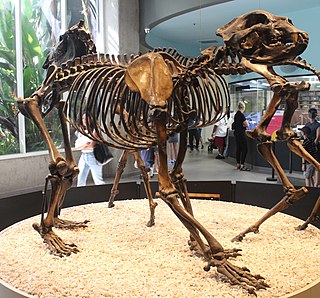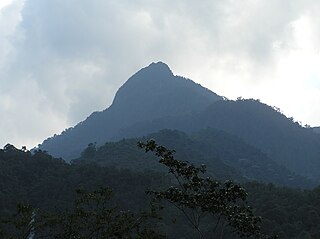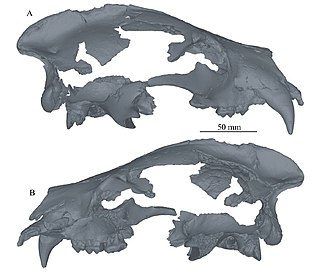
Bears are carnivoran mammals of the family Ursidae. They are classified as caniforms, or doglike carnivorans. Although only eight species of bears are extant, they are widespread, appearing in a wide variety of habitats throughout most of the Northern Hemisphere and partially in the Southern Hemisphere. Bears are found on the continents of North America, South America, and Eurasia. Common characteristics of modern bears include large bodies with stocky legs, long snouts, small rounded ears, shaggy hair, plantigrade paws with five nonretractile claws, and short tails.

The Nearctic realm is one of the eight biogeographic realms constituting the Earth's land surface.

The spectacled bear, also known as the South American bear, Andean bear, Andean short-faced bear or mountain bear and locally as jukumari, ukumari (Quechua) or ukuku, is a species of bear native to the Andes Mountains in northern and western South America. It is the only living species of bear native to South America, and the last remaining short-faced bear. Its closest relatives are the extinct Tremarctos floridanus, and the giant short-faced bears, which became extinct at the end of the Pleistocene around 12,000 years ago. The diet of the spectacled bear is mostly herbivorous, but it occasionally engages in carnivorous behavior. The species is classified as Vulnerable by the IUCN because of habitat loss.

The Rio Abiseo National Park is located in the San Martín department of Peru. UNESCO pronounced it as Natural and Cultural Heritage of Humanity in 1990. The park is home to many species of flora and fauna, as well as the location of over 30 pre-Columbian archaeological sites. Since 1986, the park has not been open to tourism due to the fragile nature of both the natural and archaeological environment.

Chapalmalania is an extinct genus of procyonid from the Late Miocene or Early Pliocene to Early Pleistocene of Argentina, Venezuela, and Colombia.

The Tropical Andes is northern of the three climate-delineated parts of the Andes, the others being the Dry Andes and the Wet Andes. The Tropical Andes' area spans 1,542,644 km2 (595,618 sq mi).

The Tremarctinae or short-faced bears is a subfamily of Ursidae that contains one living representative, the spectacled bear of South America, and several extinct species from four genera: the Florida spectacled bear, the North American giant short-faced bears Arctodus, the South American giant short-faced bear Arctotherium as well as Plionarctos(P. edensis and P. harroldorum), which is thought to be ancestral to the other three genera. Of these, the giant short-faced bears may have been the largest ever carnivorans in the Americas. The group is thought to have originated in eastern North America, and then invaded South America as part of the Great American Interchange. Most short-faced bears became extinct at the end of the Pleistocene.

Bear conservation refers to the management of bears and their habitat with a view to preventing their extinction.

Tremarctos floridanus, occasionally called the Florida spectacled bear, Florida cave bear, or rarely Florida short-faced bear, is an extinct species of bear in the family Ursidae, subfamily Tremarctinae. T. floridanus was widespread in the Southeastern United States during the Rancholabrean epoch, with scattered reports of fossils from other parts of North America and from earlier epochs.

Arctodus is an extinct genus of short-faced bear that inhabited North America during the Pleistocene. There are two recognized species: the lesser short-faced bear and the giant short-faced bear. Of these species, A. simus was larger, is known from more complete remains, and is considered one of the most charismatic of North America's megafauna. A. pristinus was largely restricted to the Early Pleistocene of the Eastern United States, whereas A. simus had a broader range, with most finds being from the Late Pleistocene of the United States, Mexico and Canada. A. simus evolved from A. pristinus, but both species likely overlapped in the Middle Pleistocene. Both species are relatively rare in the fossil record.

Farallones de Cali is a cluster of mountains in the West Andes of Colombia. It is located west of the city of Cali and gives rise to many of the rivers that provide water and electricity to Cali. The PNN Farallones de Cali encompasses 150,000 ha (580 sq mi) in the mountains as well as much of the Pacific slope and is an area of very high biodiversity. The average temperature ranges from 25 °C (77 °F) in the tropical foothills to 5 °C (41 °F) in the páramo. In this territory are located the district of Pichinde, Andes and Leonera, and two villages Penas Blancas and Lomas de la Cajita.

Ursavus is an extinct genus of bear that existed in North America, Europe, and Asia during the Miocene period, about 23–5.3 million years ago (Mya), existing for roughly 17.7 million years. The genus apparently dispersed from Asia into North America about 20 Mya, becoming the earliest member of the subfamily Ursinae in the New World. Qiu points out that if a questionable 29 million-year-old specimen of Ursavus reported in North America is validated, Ursavus may have evolved in North America and dispersed westward into Asia. The higher number of fossils in Europe grading toward eastern Asia make the westward dispersal unlikely.
Plionarctos is an extinct genus of bear endemic to North America from the Miocene to the Pliocene, ~10.3—3.3 Mya, existing for about 7 million years.

Arctotherium is an extinct genus of the Pleistocene short-faced bears endemic to Central and South America. Arctotherium migrated from North America to South America during the Great American Interchange, following the formation of the Isthmus of Panama during the late Pliocene. The genus consists of one early giant form, A. angustidens, and several succeeding smaller species, which were within the size range of modern bears. Arctotherium was adapted to open and mixed habitat. They are genetically closer to the spectacled bear, than to Arctodus of North America, implying the two extinct forms evolved large size in a convergent manner.

The Bolivian Yungas is a tropical and subtropical moist broadleaf forest ecoregion in the Yungas of central Bolivia.
The Cutler Fossil Site (8DA2001) is a sinkhole near Biscayne Bay in Palmetto Bay, Florida, which is south of Miami. The site has yielded bones of Pleistocene animals and bones as well as artifacts of Paleo-Indians and people of the Archaic period.
The Paramillo Massif is a mountain range of the Tropical Andes System, located at the northern end of the Cordillera Occidental range in Colombia.

Spectacled Bear Conservation (SBC) is a team of researchers and conservationists working to study and protect the endangered spectacled bear, also known as the Andean bear. Spectacled bears are the only surviving species of bear native to South America, and the only surviving member of the subfamily Tremarctinae, the short-faced bears. Their range is the Andean Mountains from Venezuela to Chile.

Protarctos is an extinct genus of basal ursine bear that lived in North America and Eurasia during the Pliocene and into Early Pleistocene.
















